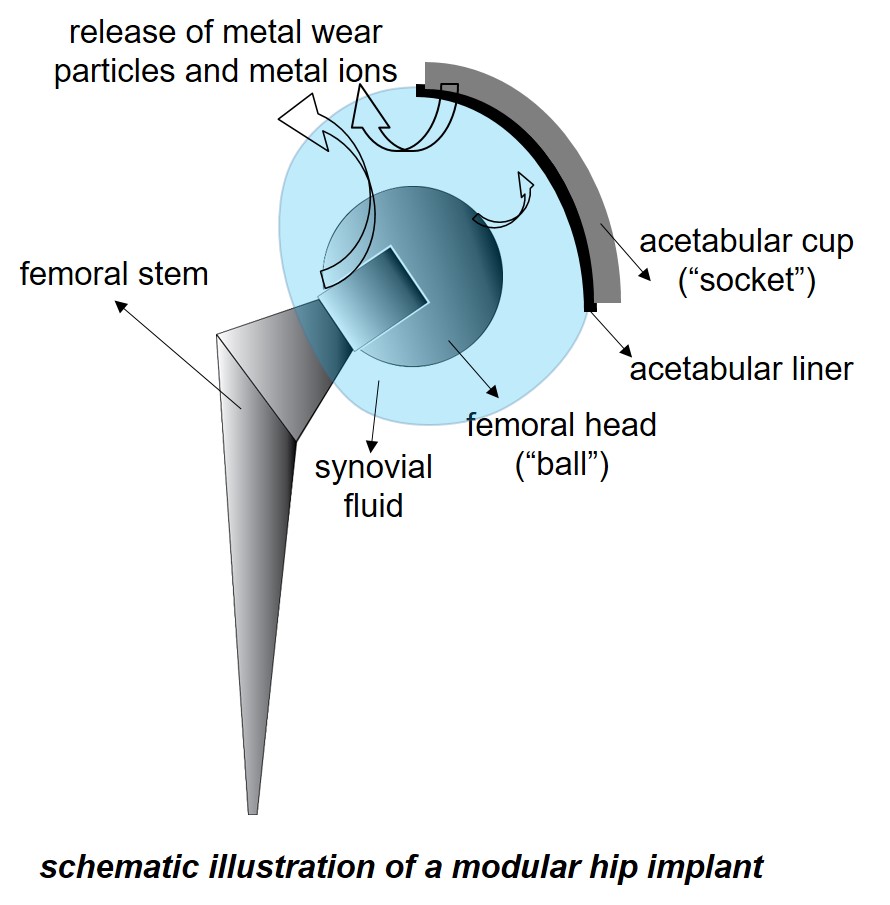Total hip replacement surgery, known as total hip arthroplasty, is recommended to improve the quality of life of patients suffering from arthritic or traumatized hip joints [1][2][3][4]. This treatment option is usually suggested only after other non-invasive solutions such as physiotherapy, lifestyle changes, walking supports, and pain medications are insufficient.
The need for hip replacement surgery
In a human hip joint, the round “head” of the thighbone (femur) articulates in the cup-like “socket” of the hipbone (pelvis), similar to a ball-in-socket assembly. The smooth movement in a healthy hip is enabled by lubrication and shock absorption provided by cartilage and synovial fluid present in the hip joint cavity. Arthritis or injury can lead to irrevocable damage of all or part of the hip joint. During a total hip replacement surgery, these components are replaced by biomaterials designed to mimic the mechanics of the joint.
Statistical studies predict that the global demand for these total hip replacement surgeries will double from 2015 to 2050 [5]. These surgeries are widely considered as highly effective with success rates >95% [6].
Primary hip replacement surgery and the possibility of revision surgeries
During the initial (primary) hip replacement surgery, the “ball” part of the implant, which is attached to a long “stem,” is hammered into the thighbone to replace the round head of the thighbone (check out the schematic illustration below). The “socket” part of the implant consists of a metallic cup with a liner. If the implant fails in the patient during use, doctors have to perform revision surgeries in order to replace it. These surgeries are more expensive and carry a higher risk of complications than the primary surgery [7][8]. Replacing an implant during a revision surgery requires removing the well-fixed femoral “stem” from the bone and replacing it with a longer “stem.” This limits the number of times revision surgeries can be performed to until when the patient does not have any more thighbone to insert the stem into and hence it is not possible to perform more than three revision surgeries.
Reasons for hip implant failure
According to Sir John Charnley, who pioneered hip replacement surgery in 1961, “Neither surgeons or engineers will ever make an artificial hip-joint which will last thirty years and at some time in this period enable the patient to play football” [12]. However, advances in modern hip implant materials and design, as well as surgical techniques have resulted in younger patients with more active lifestyles and longer life expectancies undergoing these surgeries [9][10]. In addition, the susceptibility of a hip implant to fail is dependent both on its design and well as the material(s) used in the design.
Hip implants designs
Currently, there is no standard hip implant design available. Orthopedic surgeons choose a suitable hip implant device based on the age, activity level, and body measurements of each patient. The following are some of the hip implant designs available in the medical device market.
Metal-on-Metal implant designs: In this implant, the “ball” part of the implant is a metallic alloy, and the “socket” has a metal lining. Medical device regulatory agencies in the U. S and U. K have raised alerts on metal-on-metal implants due to concerns about metal released from the implant during use [11][12].
Metal-on-Polymer implant designs: The metal “ball” articulates on the polymer lining of the “socket.”
Ceramic-based implant designs: These designs include devices such as Ceramic-on-Polyethylene, Ceramic-on-Ceramic, and Ceramic-on-Metal implants. They refer to the different bearing surfaces articulating against each other in the artificial hip.
Modular hip implant designs: Modular implants are manufactured as separate components and “locked” together during the surgery [13]. For instance, the surgeon can hammer the “stem” component into the thighbone and then insert the head (“ball”) onto the “stem.” The “head” and “stem” can be locked together by applying sufficient force. The schematic diagram below illustrates an implant with a modular “stem” and “head.”

Modular hip implants offer several benefits: During revision surgeries, surgeons can replace only the damaged part of the implant without removing the well-fixed “stem” component from the bone. In addition, the different components of modular implants made from different biomedical alloys in order to take advantage of their best properties [14]. Orthopedic surgeons too favor modular hip implant design to ease the surgery [15]. The alerts raised on specific designs and market recalls of implants can be checked in online databases [16].
Hip implant materials
Implant materials have to be biocompatible, possess the required load-bearing capacity, be resistant to fatigue, and easily integrate with the bone. In addition, the material should be corrosion resistant in the aggressive inflammatory environment of the hip joint cavity. Biomedical alloys have been used for decades to create the “ball” and “socket” in artificial hips [2][17], with stainless steel, cobalt-chromium alloys, titanium alloys [18] being the most commonly used. Ultra-high weight polyethylene is commonly used as the lining of the “socket.” Ceramics are being introduced as the “head” in modular hip implant designs due to their wear-resistant properties and chemical inertness.
However, there is no perfect material that can be used in the hip implant. Metals are susceptible to corrosion; polymers are susceptible to wear, and ceramics are susceptible to fracture.
Conclusion
The reasons a hip implant fails during use is dependent on multiple factors such as the patient’s age and activity of the patient, the implant material, and design as well as the surgeon.
Recommendations
People who have been advised to undergo a total hip replacement are recommended to be aware of the current implant materials and designs available in the medical device market and finalize a treatment after discussing the merits and possible consequences of each implant design with the medical team. The next blog will describe the impacts in the body after implanting hip replacement devices.
References
[1] Eisler. T. et al., The Journal of Arthroplasty, 17(4), 2002, 457-462.
[2] Older. J., The Journal of Arthroplasty, 17(6), 2002, 675-680.
[3] Kavanagh. B. F. et al., The Journal of Arthroplasty, 9(3), 1994, 229-234.
[4] Neumann. L. et al., J Bone Joint Surg Am., 76-B(2), 1994, 245-251.
[5] Christof Pabinger. H. L. et al., Hip International, 28(5), 2018, 498-506.
[6] Ulrich. S. D. et al., International Orthopaedics, 32(5), 2008, 597-604.
[7] Mahomed. N. N. et al., J. Bone Joint Surg.-Am., 85A(1), 2003, 27-32.
[8] Bozic. K. J. et al., J. Bone Joint Surg.-Am., 91A(1), 2009, 128-133.
[9] Kurtz. S. M. et al., Clin. Orthop. Rel. Res., 467(10), 2009, 2606 – 2612.
[10] Patel. A. et al., Bone Joint Journal, 97B (8), 2015, 1076-1081.
[11] https://www.federalregister.gov/documents/2016/02/18/2016-03331/effective-date-of-requirement-for-premarket-approval-for-total-metal-on-metal-semi-constrained-hip/
[12] https://www.gov.uk/drug-device-alerts/all-metal-on-metal-mom-hip-replacements-updated-advice-for-follow-up-of-patients/
[13] Hernigou. P. et al., International Orthopaedics, 37(10), 2013, 2081-2088.
[14] Schmalzried. T. P., Seminars in Arthroplasty, 27(4), 2016, 232-234.
[15] Mihalko. W. M., Survey results concerning modular taper junctions among Fellows of teh American Academy of Orthopaedic Surgeons, ASTM Work. Modul. Tapers Total Jt. Replace. Devices, Jackonvile, FL, 2013.
[16] https://medicaldevices.icij.org/ International Medical Devices Database.
[17] Charnley. J., The Lancet, 277(7187), 1961, 1129-1132.
[18] Eliaz. N., Corrosion of Metallic Biomaterials: A Review, 12(3), 2019, 407.


7 comments
This article is a true testament to the power of quality journalism to inform and educate readers on important issues. The author’s ability to present complex issues in a clear and engaging manner is truly impressive, and their commitment to presenting balanced and unbiased perspectives is admirable. What I appreciate most about this article is its ability to tackle complex issues and present them in a way that is accessible and engaging for readers of all levels. Whether you’re looking to learn something new or simply looking for an interesting read, this article is a must-read.
As I website possessor I believe the content here is rattling excellent, thank you for your efforts.
Great and informative post.
Very deep research! Useful information , some i didn’t even know about before . Thank you for the work
great post
This is a well-researched article about hip replacement procedures. Thank you for providing info about this common procedure.
Comments are closed.